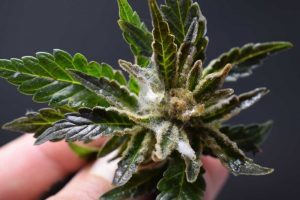Link
Grinding cannabis is an important step in preparing it for use, as it can help improve the efficiency of extraction and ensure a more consistent burn. Here are some steps for grinding cannabis
Choose a Grinder: There are several types of grinders available, including manual grinders, electric grinders, and even grinders built into storage containers. Choose a grinder that suits your needs and budget.
Break Up the Buds: Before grinding, use your hands or a pair of scissors to break up the larger buds into smaller pieces.
Load the Grinder: Place the broken-up cannabis into the grinder, making sure not to overfill it. For best results, aim to fill the grinder about halfway.
Grind the Cannabis: Twist the lid of the grinder back and forth, applying firm pressure, until the cannabis is finely ground. This may take several twists, depending on the type of grinder and the desired fineness of the grind.
Remove the Ground Cannabis: Once the cannabis is ground to your desired consistency, carefully remove it from the grinder and transfer it to a storage container or rolling paper.
It's important to note that grinding cannabis can produce a strong smell, so it's a good idea to do it in a well-ventilated area or outside. Also, be sure to clean your grinder regularly to prevent buildup and maintain optimal performance.
4 notes
·
View notes
Link
The aroma and flavor of marijuana can vary depending on the specific strain and growing conditions, but generally, it has a distinct smell and taste that is often described as earthy, skunky, or spicy.
Some strains may have a more fruity or sweet aroma and flavor, while others may have more herbal or floral notes. Some strains may also have hints of pine, citrus, or diesel.
In addition to the aroma and flavor of the plant itself, when marijuana is smoked or vaporized, it can also produce a range of secondary aromas and flavors, including smoke, ash, and resin.
Overall, the aroma and flavor of marijuana can be complex and varied, and can depend on many factors, including the strain, growing conditions, and method of consumption.
1 note
·
View note
Link
Cannabis has been shown to be effective in treating nausea through several mechanisms, including its ability to interact with the endocannabinoid system, which plays a role in regulating nausea and vomiting.
Here are some of the ways that cannabis may help treat nausea:
Activation of CB1 Receptors: THC, the psychoactive compound in cannabis, activates CB1 receptors in the brain and digestive system, which can help reduce nausea and vomiting.
Interaction with Serotonin Receptors: CBD, another compound found in cannabis, interacts with serotonin receptors in the brain, which are involved in regulating nausea and vomiting.
Anti-inflammatory Effects: Cannabis has anti-inflammatory properties, which may help reduce inflammation in the digestive tract that can contribute to nausea.
Appetite Stimulation: THC has been shown to stimulate appetite, which can be helpful in treating nausea caused by loss of appetite.
Reduction of Anxiety: Cannabis may help reduce anxiety, which can be a contributing factor to nausea.
Overall, cannabis has been shown to be effective in treating nausea caused by chemotherapy, motion sickness, and other conditions. However, it's important to note that the use of cannabis, whether for medical or recreational purposes, may have side effects and can be associated with risks, and should always be discussed with a healthcare professional.
2 notes
·
View notes
Link
There is not a specific CBD receptor in humans. However, CBD can interact with several receptors in the body, including cannabinoid receptors, which are part of the endocannabinoid system.
The endocannabinoid system is a complex network of receptors and neurotransmitters that helps regulate many physiological processes, including pain, mood, appetite, and immune function. The two main cannabinoid receptors are CB1 and CB2.
CB1 receptors are primarily found in the brain and central nervous system, and they play a role in regulating mood, appetite, pain sensation, and memory. THC, the psychoactive compound in cannabis, binds to CB1 receptors and produces its characteristic high.
CB2 receptors are primarily found in immune cells and play a role in regulating inflammation and immune function. CBD has been shown to interact with CB2 receptors, as well as other receptors such as 5-HT1A (a serotonin receptor), TRPV1 (a vanilloid receptor), and GPR55 (a G protein-coupled receptor).
CBD's interaction with these receptors and neurotransmitters may be responsible for its potential therapeutic effects, including reducing anxiety, improving sleep, and reducing seizures in some people with epilepsy.
1 note
·
View note
Link
Yes, cannabis has been shown to be an effective treatment for nausea, including nausea caused by chemotherapy, motion sickness, and other conditions.
Both THC and CBD have been shown to have anti-nausea effects. THC activates CB1 receptors in the brain and digestive system, which can help reduce nausea and vomiting. CBD also has anti-nausea effects, although the mechanism of action is not yet fully understood.
In fact, there are several prescription drugs that contain THC and/or CBD and are approved by the FDA for the treatment of nausea and vomiting caused by chemotherapy. These drugs include dronabinol (Marinol) and nabilone (Cesamet), which are synthetic forms of THC, and a combination of THC and CBD called nabiximols (Sativex).
In addition to these prescription drugs, some people use medical cannabis to help alleviate nausea. However, it's important to note that the use of cannabis, whether for medical or recreational purposes, may have side effects and can be associated with risks, and should always be discussed with a healthcare professional.
1 note
·
View note












